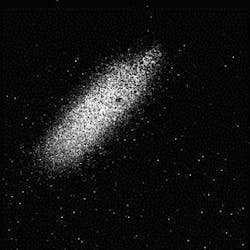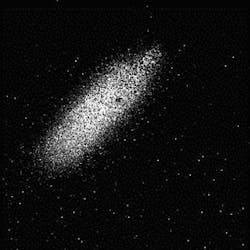Quantum dots allow normal-incidence imaging
Quantum-well infrared photodetectors (QWIPs) can serve as elements in focal-plane-array (FPA) cameras for capturing middle- and long-wavelength IR images. Valued by the military, QWIP-based FPAs also have found commercial uses in night vision. A QWIP does not absorb much light at normal incidence, however, because the optical transition for light striking normal to the surface is forbidden. Gratings or other tricks can be used to skirt this problem, but the additional fabrication steps increase cost.
An alternative to the QWIP approach is the quantum-dot infrared detector (QDIP), which does allow for absorption of normal-incidence light. Now a group of researchers from Northwestern University (Evanston, IL), the Air Force Research Laboratory (Wright-Patterson AFB, OH), and the Missile Defense Agency (Washington, D.C.) has fabricated and tested the first QDIP FPA.
Using low-pressure metal-organic chemical-vapor deposition (MOCVD), the researchers fabricated a 256 × 256-pixel FPA based on indium gallium arsenide quantum dots, an indium gallium phosphide barrier, and a gallium arsenide (GaAs) substrate. The quantum dots were formed by self-assembly. The die was hybridized to a readout chip via flip-chip bonding, the gap filled, and the GaAs substrate thinned to 30 µm.
"The biggest challenge of the fabrication process for the FPA is how to achieve the lower noise-equivalent temperature difference (NEDT, or NEDT), which is the most important parameter of an infrared FPA," says Manijeh Razeghi, one of the Northwestern University scientists. "The fabrication of a QDIP FPA is a fairly complicated process. Many technologies are involved, such as MOCVD epitaxy, photolithography, plasma etching, flip-chip bonding, and so on. For a QDIP FPA, self-assembled quantum dots with high density and high uniformity are the key to achieving a smaller NEDT."
A test of the QDIP FPA was conducted at a 300-K background temperature, a frame rate of 53 Hz, and with an f/2.3 imaging lens. With 90% of the pixels operational, the very first device produced good images (see figure). The peak photoresponse was at 4.7-µm wavelength with a cutoff at 5.2 µm. Although the estimated theoretical NEDT was 87 mK, the device actually showed an NEDT of 509 mK, which is probably a result of nonuniform pixels. The 10% nonoperational pixels arose from the very shallow (2-µm) indium bumps used in the flip-chip bonding, causing some poor connections to the readout units. The current-injection efficiency was approximately 90% at a bias of -1.6 V.
In addition to normal-incidence operation resulting from the 3-D confinement of quantum dots, another advantage of QDIPs over QWIPs was evident as well in the prototype. While equivalent QWIPs operate at a temperature of 67 K, the QDIP FPA prototype imaged well at temperatures up to 120 K, says Razeghi.
"Today, most infrared FPAs are based on QWIPs or mercury cadmium telluride (MCT) intrinsic photodetectors," says Razeghi. "Due to problems related to the MCT material system, it is difficult to achieve high-uniformity MCT detector arrays; FPAs based on MCT suffer high cost and low yield." In addition to the normal-incidence problem suffered by QWIPs, neither QWIP or MCT FPAs are not suitable for high-temperature operation, notes Razeghi. "With further research and development, QDIP FPAs are expected to achieve performances comparable to or better than MCT or QWIP FPAs while operating at much higher temperatures," she adds.

